Important Questions for Class 8 Maths - Mensuration
| Table of contents |

|
| Match the column |

|
| Fill in the blanks |

|
| True & False |

|
| Answer the following questions |

|
Match the column
Q1:
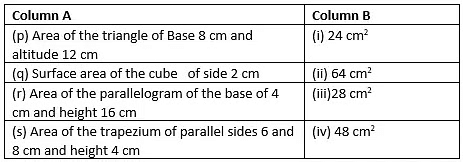 Ans:
Ans:(p) → (iv)
(q) → (i)
(r) → (ii)
(s) → (iii)
Sol :
Q2:
 Ans:
Ans:
(p) → (ii)
(q) → (iii)
(r) → (i)
Sol: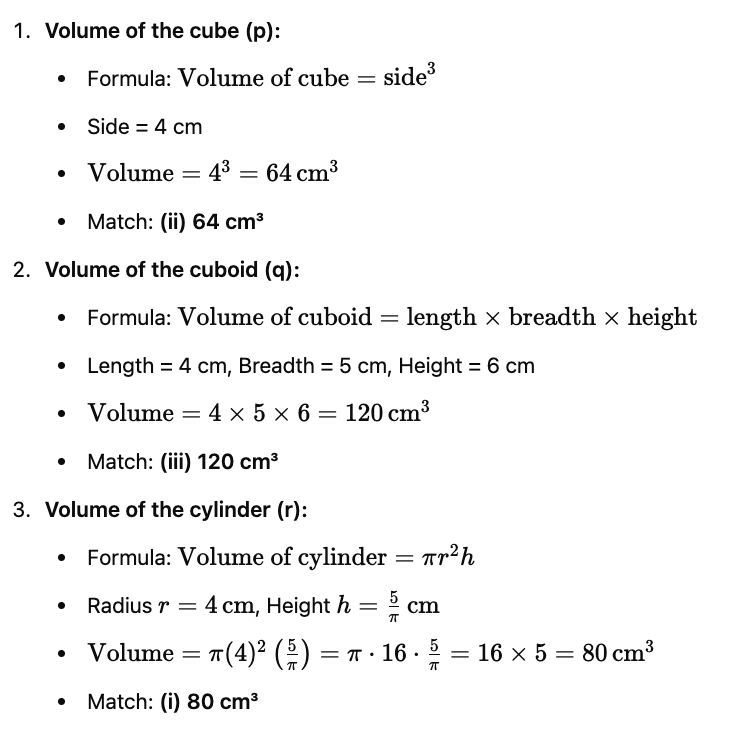
Fill in the blanks
(i) Curved surface area of a cylinder of radius 2b and height 2a is _______.
(ii) Volume of a cylinder with radius p and height q is __________.
(iii) 6.55m2= ______cm2
(iv)The volume of a cylinder becomes __________ the original volume if its radius becomes doubles of the original radius and height becomes half of its original values
Ans:
(i) 8πab
Sol: S = 2πrH
= 2π × 2b × 2a
= 8πab
(ii) πp2q
Sol: V=π r2H
Substituting value of radius = p and Height = q
We get ,
V=π p2q
(iii) 65,500cm2
Sol: 1 m2 = 10,000 cm2
6.55m2 = 6.55×10,000cm2 = 65,500cm2
(iv)double
Sol:V1= πr2H,
V2=π(2r)2(1/2)H
=2πr2H,
So it becomes doubleTrue & False
(i) Amount of region occupied by a solid is called its surface area
(ii)The areas of any two faces of a cube are equal.
(iii)The areas of two oppossite faces of a cuboid are equal.
(iv) 2.5 litres is equal to 0.025 cubic meters
(v) Total surface area of cuboid is 2h (l + b).
Ans:
(i)False
Sol: The amount of region occupied by a solid is called its volume, not surface area.
(ii)True
Sol: All six faces of a cube are squares and have equal areas.
(iii) True
Sol: Opposite faces of a cuboid are identical in dimensions, hence their areas are equal.
(iv) False
Sol: 1litre = 0.001m3, so 2.5litres = 2.5 × 0.001 = 0.0025m3. (This makes it True, correcting the prior explanation.)
(v) False
Sol: Total surface area of cuboid = 2(lb + bh + hl), not 2h (l + b).
Answer the following questions
Q1: The parallel sides of a trapezium are 20 cm and 10 cm. Its nonparallel sides are both equal, each being 13 cm. Find the area of the trapezium.
Sol:Let ABCD is the trapezium with AB and CD are the parallel sides.
Now
AB=10 cm, CD=20 cm, BC=13 cm
Now draw line BE || AD and draw a perpendicular from B on EC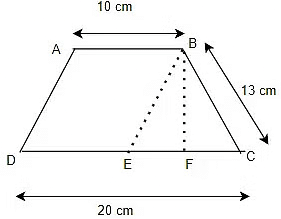 Now ABED is a parallelogram, then BE=13 cm
Now ABED is a parallelogram, then BE=13 cm
In triangle BEC, BE =BC, So Isoceles triangle,So perpendicular will bisect the EC
Hence EF = FC
Now EC= DC -DE = 20 -10 =10 cm
Therefore EF = FC = EC/2 = 5 cm
Now in Triangle BEF, it is right angle at F,So by pythagorous theorem
BE2 = BF2 + EF2
169 = BF2 + 25
BF= 12cm
This is also the perpendicular distance between the parallel sides. So now coming back to Area of trapezium
A = 1/2[a + b] × h
Here a = 10 cm , b = 20 cm, h = 12 cm., A =?
Therefore
A = 1/2[10 + 20]×12
A = 180cm2
Q2: The area of a rhombus is 300 cm², and one of the diagonals is 20 cm. Find the other diagonal.
Sol: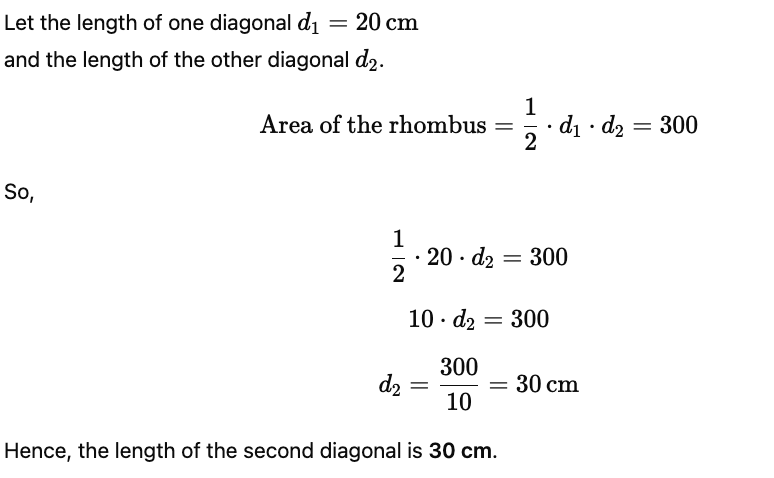 Q3: A circular garden has a radius of 14 m. Find the cost of fencing the garden along its circumference at the rate of ₹12 per meter.
Q3: A circular garden has a radius of 14 m. Find the cost of fencing the garden along its circumference at the rate of ₹12 per meter.
Sol: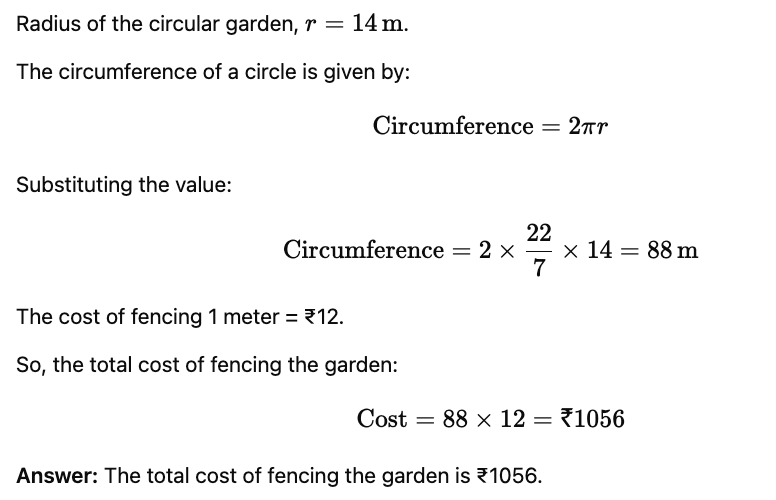 Q4: Find the area of a trapezium whose parallel sides are 38.7 cm and 22.3 cm, and the distance between them is 18 cm.
Q4: Find the area of a trapezium whose parallel sides are 38.7 cm and 22.3 cm, and the distance between them is 18 cm.
Sol: Area of trapezium = Half the product of the sum of the lengths of parallel sides and the perpendicular distance between them gives the
A = 1/2[a + b] × h
Here a = 38.7 cm , b = 22.3 cm h = 18 cm
Therefore
A = 1/2[38.7 + 22.3] × 18
= 549cm2
Q5: Find the area of a trapezium whose parallel sides are 12 cm and 20 cm and the distance between them is 15 cm.
Sol:
Area of trapezium = Half the product of the sum of the lengths of parallel sides and the perpendicular distance between them gives the
A = 12[a + b] × h
Here a = 12 cm , b = 20 cm h =15 cm
Therefore
A = 12[12 + 20] × 15
= 240cm2
Q6: A box in the form of a cuboid has external dimensions of 60 cm × 40 cm × 30 cm. The top face, two side faces, and the front face are to be painted with a glossy finish. Calculate the area that needs to be painted.
Sol: Q7: The area of a trapezium is 384cm2. Its parallel sides are in the ratio 2: 6 and the perpendicular distance between them is 12 cm. Find the length of each of the parallel sides.
Q7: The area of a trapezium is 384cm2. Its parallel sides are in the ratio 2: 6 and the perpendicular distance between them is 12 cm. Find the length of each of the parallel sides.
Sol:
Area of trapezium=Half the product of the sum of the lengths of parallel sides and the perpendicular distance between them gives the
A = 12[a + b] × h
Here a = 2x cm , b = 6x, h = 12 cm., A = 384 cm2
Therefore
384 = 12[2x + 6x] × 12
x = 8cm
So parallel sides are 16 cm and 48 cm
Q8: A cylindrical road roller makes 750 complete revolutions to level a road. The diameter of the roller is 84 cm, and its length is 1 m. Calculate the total area leveled by the road roller.
Sol: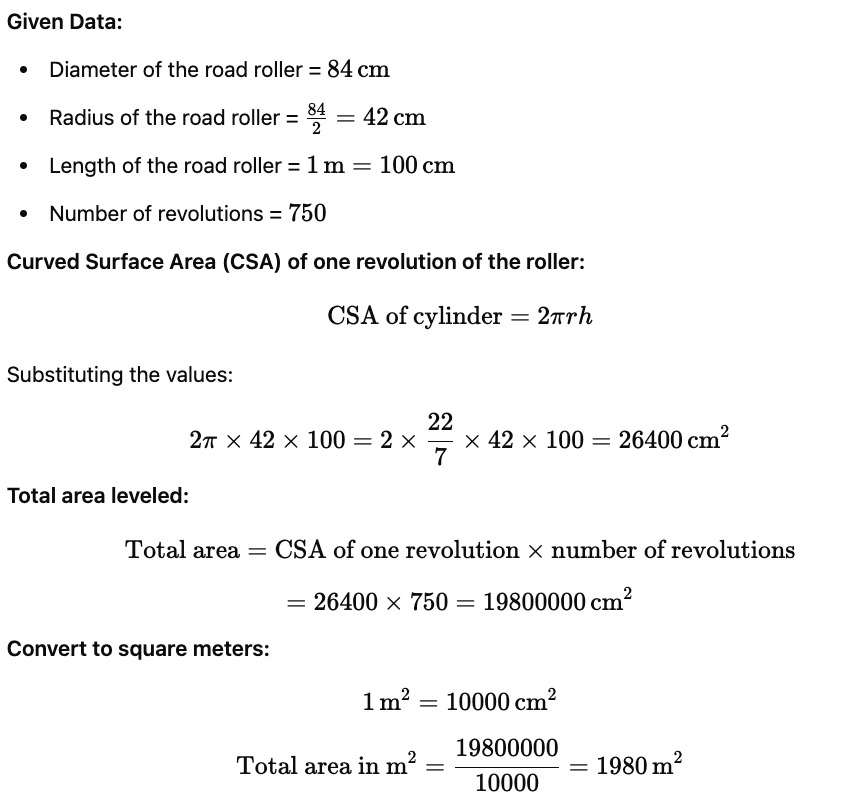
Q9: A rectangular piece of cardboard measuring 18 cm × 7 cm is folded without overlapping to make a cylinder of height 7 cm. Find the volume of the cylinder.
Sol:
Q10: A storage room is in the shape of a cuboid with dimensions 50 m × 30 m × 20 m. How many smaller cuboidal containers of volume 1.2 m³ can be stored in it?
Sol: 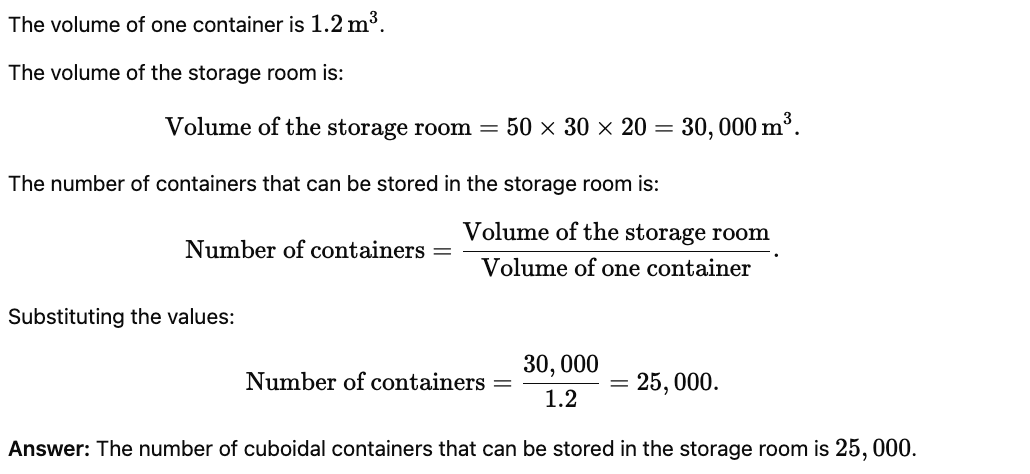
|
81 videos|423 docs|31 tests
|
FAQs on Important Questions for Class 8 Maths - Mensuration
| 1. What is mensuration in mathematics? |  |
| 2. How do you calculate the area of a rectangle? |  |
| 3. What is the formula for finding the volume of a cylinder? |  |
| 4. What is the difference between perimeter and area? |  |
| 5. How can I find the surface area of a cube? |  |





















